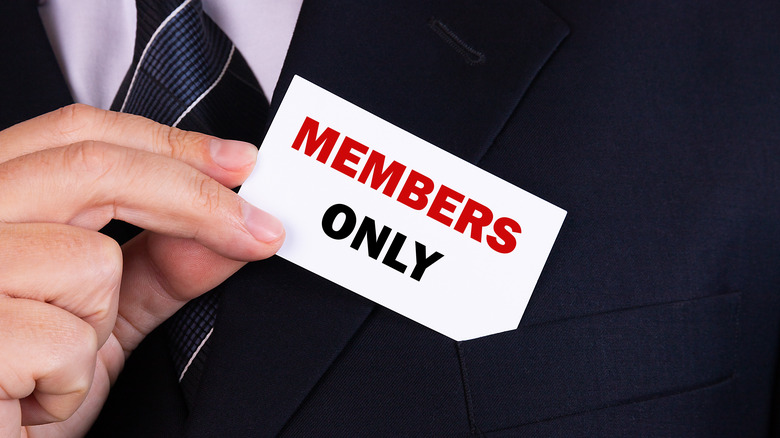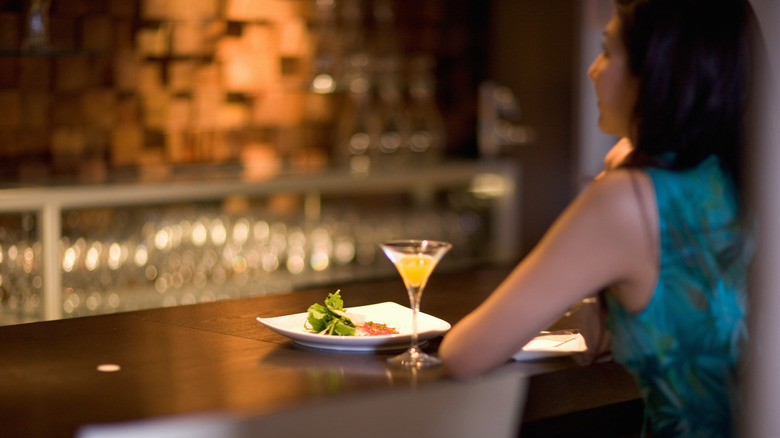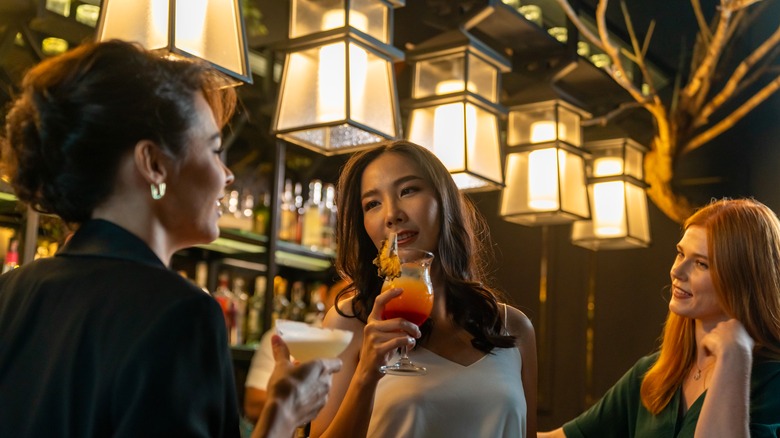Why Do People Pay For Access To Private Bars And Restaurants?
If you happen to live in Manhattan, you know all too well that going out on a Saturday night often means at least a $20(ish) entry fee. In major metropolitan areas, even at "affordable" bars and clubs, you can expect to fork over at least a 10-spot to get in. But, at private bars and restaurants, it's an entirely different scene.
Subsix in the Maldives is a bar located six meters below the surface of the Indian Ocean, per Atlas Obscura. It's like an aquarium, but you're the fish, and you're paying $25 per drink. Plus, you can only get there by boat. (Fans of the 2022 film "The Menu," rise up.) But $25 is downright cheap compared to many other private establishments. The door of Detroit's Bad Luck Bar remains locked. Folks need to call or knock if they want to get in, and once they're inside, the bar's signature cocktails run for $25-$60 a pop. At Artesian, the hotel bar of The Langham in London, you can drink a $335 bottle of 2009 Dom Pérignon on a purple leather couch. Feel free to order a $645 bottle of champagne next time you visit the American Bar at the Savoy in London.
According to Bon Appétit, some private bars and restaurants around the world charge as much as $50,000 in annual member fees, sometimes compounded on top of even pricier initiation fees. So why would anybody pay for it? What's the appeal?
A sense of normalcy (believe it or not)
Instantly-recognizable celebrities and world leaders might be paying for anonymity, notes Verdict. At exclusively upper-crust establishments like these, "important people" are only in the company of other A-listers. As Sam Stone of Bon Appétit puts it, "With the private restaurant experience ... it's important to be chill about one's wealth." That means famous folks can enjoy a nice dinner out without worrying about gawkers snapping a photo or asking for an autograph. Ernest Hemingway, for example, was a consistent regular at El Floridita in Havana for over two decades. The writer's distaste for the public is legendary, and he would only occasionally relent and suffer them, believing "An intelligent man sometimes has to be drunk to spend time with idiots." While this isn't necessarily a meritorious worldview, it does speak to the appeal of establishments that can offer solace to figures prominently in the public eye. According to Robb Report, David Bowie was one that belonged to the members-only bar Soho House in the early 2000s.
Indeed, even bars that don't identify as members-only or charge separate entrance fees often charge prices so steep that only the top 1% can afford to visit. At Blue Bar in Times Square, one of the signature drinks is a $10,000 martini. Forking over that much for gin and vermouth comes with a built-in door fee. But what about the rest of us — the non-celebrity foodies? Why would "regular" folks pay for access to private bars and restaurants?
A sense of community
Inside the Manhattan photography museum Fotografiska, Chapel Bar hosts live events, exclusive cocktails, and something teased as "the occasional confession." But you have to be a member to see any of it. On its website, memberships are advertised as being "For the Bon Vivants, Provocateurs, and Culturati," and they don't come without a highly selective application process. According to Bon Appétit, yearly member fees at Chapel Bar cost in the ballpark of $2,500. But, the appeal of private clubs like these isn't exclusive to major cities. In Vermilion, O.H. — a town on the bank of Lake Erie with a population of just over 10,000 and a median household income of $66,148 — membership at the Vermilion Boat Club (a private dining club) costs $1,942 a year on top of a $1,500 initiation fee.
In both of these exclusive establishments, the common denominator is a shared passion. Patrons of Chapel Bar are connected by a shared love of art in the same way that VBC members love boating. It's a paid social club as much as a college fraternity or sorority is. Members-only bars and restaurants like these foster a sense of community not dissimilar to hanging out with the regular, familiar crowd at a favorite local dive bar. The prices may be wildly different from your normal beer and a shot combo, but the appeal of the joints is largely the same.


